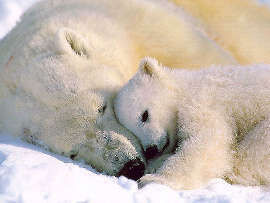Arctic Land Mammals
 It is vital for a mammal, being a ‘warm-blooded’ vertebrate, to keep warm in order to maintain its body at a constant temperature. If it cannot do this it will die. The Arctic is the coldest place inhabited by land mammals and these have very thick fur, which insulates the body by trapping air. They also have a layer of stored fat under the skin which gives additional insulation.
It is vital for a mammal, being a ‘warm-blooded’ vertebrate, to keep warm in order to maintain its body at a constant temperature. If it cannot do this it will die. The Arctic is the coldest place inhabited by land mammals and these have very thick fur, which insulates the body by trapping air. They also have a layer of stored fat under the skin which gives additional insulation.
Like many Arctic mammals, the polar bear has white fur made of hollow hairs, which traps and warms air. Ultra-violet light is funnelled from the sun down the hairs to the bear’s black skin, changing it into warmth. The dense undercoat is covered with an outer coat of long guard hairs. These help to keep the polar bear dry and warm while it is swimming. To find out more about the life of polar bears visit our Polar Bear factsheet.
The body shape and size of many cold climate mammals differ quite a lot from similar species living in warmer areas. Generally an animal becomes rounder and bulkier when its environment is very cold. Also its legs, ears and tail are shorter. These adaptations help to conserve heat. In short, a football-shaped animal would be warmest of all.
The Arctic fox, although certainly not as round as a football, does differ in shape from our red fox in Britain. It has a rounder, plumper body, shorter legs and tail, as well as a shorter muzzle and ears than the red fox. The thick fur turns white in the winter and the soles of the feet are covered in fur. All these adaptations allow the Arctic fox to cope with an outside temperature as low as – 40°C.
Arctic hares show similar physical adaptations to the cold. They have shorter ears and shorter, stockier legs than the brown hare of Britain. The snowshoe hare has similar sized ears and legs to the Arctic hare, but in addition it has its own built-in snowshoes i.e. enlarged hind feet, which help it when crossing soft snow.
